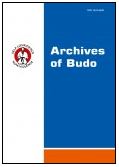2017, Volume 13
Technical principles of atemi-waza in the first technique of the itsutsu-no-kata in judo: from the viewpoint of jujutsu like atemi-waza. A broad perspective of application in honoured self-defence training
Fumiaki Shishida1, Masanori Sakaguchi2, Tadayuki Sato3, Yasuo Kawakami1
1Faculty of Sport Sciences, Waseda University, Tokyo, Japan
2Faculty of Kinesiology, University of Calgary, Calgary, Canada
3School of Sport Sciences, Waseda University, Tokyo, Japan
Author for correspondence: Fumiaki Shishida; Faculty of Sport Sciences, Waseda University, Tokyo, Japan; email: fuzanaoi[at]waseda.jp
Full text
Abstract
Background and Study Aim: Conventionally martial arts renaissance can be combined with the creation of judo by Jigoro Kano. A symbolic date may be the establishment of a Kōdōkan (1882). Further expansion not only of Japanese martial arts is the result of the intellectual effort and physical training of many generations of experts around the world. The purpose of this study is to verify the hypothesis that the truth is the opinion of Kenji Tomiki that “atemi-waza (striking technique) is, in principle, an extension of nage-waza (throwing technique)”.
Material and Methods: Verification of the hypothesis was based on three issues: (1) to make a technical analysis of Kotani & Otaki’s study, chosen among the seven previous studies, which describe the teaching of the first technique of the itsutsu-no-kata, advocated by Jigoro Kano; (2) to demonstrate the first technique of the itsutsu-no-kata, based on the interpretation by Kenji Tomiki, who referred to the unique relationship between the first technique of the itsutsu-no-kata and the atemi-waza, and to analyze its video image in terms of technique and biomechanics; (3) to clarify the technical principles of the Atemi-waza in Jujusu by synthesizing both of the above mentioned.
Results: The previous study reports that the technical principles in which tori (a person who executes a technique), who touches uke (a person to whom a technique is executed) softly with palm, and walks, defeats uke, who has turned into a solid matter, reveal the concept of “softness controls hardness,” to which Kano attached great importance. The interpretation regarding biomechanics suggested, in a scene where tori makes ceaseless pushing with palm, followed by consecutive walking. This is the reason of uke’s retreat becoming difficult gradually, and thus uke is made to walk with much shorter steps, is because tori has delicate controls over the powers on the thumb or little finger. By so doing, uke’s rotation movement on the chest is hindered, and because uke is unable to reflect on inborn movement or walking. In a scene where jizo-tashi occurs, uke is forced to lose the balance backwards, to a great extent, and as the ground reaction force gradually shifts forward. The backward moment around the uke’s centre of gravity applied by tori ’s palm, uke is unable to cancel out the reverse moment from the ground reaction force, and thus we finally observed that uke fell off, the centre of gravity being rotated, and moving backwards. This movement is considered to be jizo-taoshi.
Conclusions: Kano argues that uke will surely fall down if tori pushes ceaselessly in an effective direction, whereas Tomiki analyses this movement precisely, focusing on the palm’s force, changing its direction (angle), working on in one-point-one direction, just like the atemi-waza. The essence of Tomiki’s discovery is in the fact that the unique character of atemi-waza in judo lies in the movement where uke is made to fall down by Tori’s movement of soft-touched palm and manipulation and ceaseless movement of the body. This is interpreted as a sequence of “touch & push, push & fall down, and touch & fall down.” This leads to the feasibility of realising randori (free practice) with atemi-waza, which has been an ideal task sought by Kano. Atemi-waza fills the honoured self-defence algorithm when the soft means of counteracting are ineffective.
Key words: biomechanics, Hideichi Nagaoka, innovative agonology, Jigoro Kano, Kenji Tomiki, Sumiyuki Kotani




